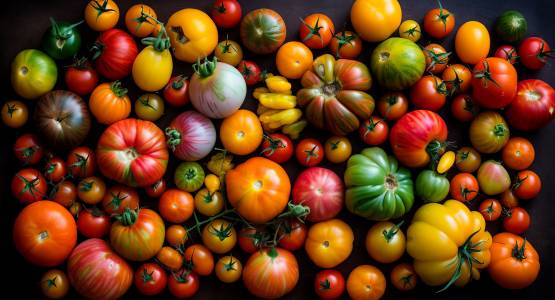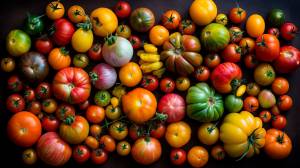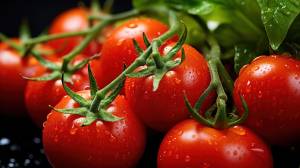What Are the Best Tomatoes to Grow in a Greenhouse in the UK?

Tomatoes are a staple in many home gardens, and growing them in a greenhouse can offer numerous benefits, particularly in the UK’s variable climate. In our “What Are the Best Tomatoes to Grow in a Greenhouse in the UK?” blog, we look at the varieties of tomato available in the UK, and give our recommendations. The controlled environment of a greenhouse allows gardeners to extend the growing season, protect plants from pests and diseases, and produce a bountiful harvest of delicious, home-grown tomatoes. In this comprehensive guide, we will explore the best tomato varieties for greenhouse growing in the UK, offer tips on plant care, discuss common pests and how to manage them, and share some delightful recipes to make the most of your home-grown tomatoes.
Why Grow Tomatoes in a Greenhouse?

Growing tomatoes in a greenhouse provides several advantages:
- Extended Growing Season: Greenhouses allow you to start your tomatoes earlier in the spring and continue growing them later into the autumn.
- Controlled Environment: You can manage temperature, humidity, and ventilation, creating optimal conditions for tomato growth.
- Pest and Disease Protection: The physical barrier of a greenhouse reduces the risk of pests and diseases that commonly affect tomatoes grown outdoors.
- Better Yields: With ideal growing conditions, tomatoes can produce higher yields of better-quality fruit.
Choosing the Right Tomato Varieties
Selecting the right tomato varieties is crucial for success. Here are some of the best varieties to grow in a greenhouse in the UK:
Gardener’s Delight
- Type: Cherry
- Description: Known for its sweet and tangy flavour, Gardener’s Delight produces small, red cherry tomatoes in abundance.
- Growing Tips: This variety is vigorous and needs regular pruning and support. Ideal for salads and snacking.
Alicante
- Type: Standard
- Description: Alicante is a popular choice for its reliable yields and excellent flavour. It produces medium-sized, round, red fruits.
- Growing Tips: Requires staking and regular feeding. Perfect for slicing and adding to sandwiches or salads.
Sungold
- Type: Cherry
- Description: Sungold tomatoes are renowned for their exceptional sweetness and vibrant orange colour.
- Growing Tips: This variety needs good support and regular watering. Ideal for fresh eating and adding a pop of colour to dishes.
Moneymaker
- Type: Standard
- Description: A classic greenhouse variety, Moneymaker produces uniform, round, red fruits with a good balance of sweetness and acidity.
- Growing Tips: This reliable variety needs staking and benefits from regular feeding. Great for all-around use in the kitchen.
Tigerella
- Type: Standard
- Description: Tigerella, also known as Mr. Stripey, produces attractive red and yellow striped fruits with a tangy flavour.
- Growing Tips: Requires support and consistent watering. Adds visual appeal and taste to salads and dishes.
Black Krim
- Type: Beefsteak
- Description: Black Krim tomatoes have a rich, smoky flavour and unique dark purple to black colour.
- Growing Tips: This variety needs strong support and regular feeding. Perfect for gourmet dishes and fresh eating.
Roma
- Type: Plum
- Description: Roma tomatoes are ideal for sauces and canning due to their dense, meaty texture and low water content.
- Growing Tips: Requires staking and consistent watering. Excellent for making homemade sauces and soups.
Planting and Care of Tomatoes
Proper planting and ongoing care are essential for healthy tomato plants and a successful harvest. This is especially true in a greenhouse:
Soil Preparation
- Soil Quality: Use high-quality, well-draining compost or soil. Incorporate organic matter such as well-rotted manure or compost to improve fertility.
- pH Level: Tomatoes prefer a slightly acidic to neutral pH (6.0-7.0). Test your soil and amend as necessary.
Sowing Tomato Seeds
- Timing: Start seeds indoors 6-8 weeks before the last expected frost date.
- Seed Trays or Pots: Sow seeds in seed trays or small pots filled with seed compost. Cover lightly with compost and water gently.
- Germination: Place in a warm location with temperatures around 21°C. Seeds should germinate in 5-10 days.
- Potting On: Once seedlings have two true leaves, transplant them into individual pots.
Transplanting Tomatoes to the Greenhouse
- Timing: Transplant seedlings into the greenhouse once they are about 15-20 cm tall and all risk of frost has passed.
- Spacing: Space plants about 45-60 cm apart to ensure good air circulation and room for growth.

- Support: Install stakes, cages, or trellises to support the plants as they grow.
Watering and Feeding Tomatoes
- Consistent Moisture: Tomatoes need consistent moisture to develop properly. Water regularly, keeping the soil evenly moist but not waterlogged.
- Feeding: Feed plants with a balanced liquid fertiliser every two weeks once fruit starts to set. Switch to a high-potassium fertiliser to promote fruit development.
Pruning and Training
- Removing Suckers: Remove side shoots (suckers) that appear in the leaf axils to direct energy to the main stem and fruits.
- Pinching Out: Pinch out the growing tips of the plant once it reaches the desired height to encourage bushier growth and more flowers.
- Supporting Fruits: As fruits develop, support them with string or small nets to prevent them from pulling the plant down.
Common Pests and Diseases
Even in a greenhouse, tomatoes can be susceptible to pests and diseases. Here’s how to manage them:
Aphids
- Identification: Small, soft-bodied insects found on new growth.
- Control: Introduce beneficial insects like ladybirds or use insecticidal soap.
Whiteflies
- Identification: Tiny white insects that fly up when disturbed.
- Control: Use yellow sticky traps and introduce natural predators like Encarsia formosa.
Spider Mites
- Identification: Tiny red or yellow mites causing fine webbing on plants.
- Control: Increase humidity and use miticides or natural predators like Phytoseiulus persimilis.
Botrytis (Grey Mould)
- Identification: Grey, fuzzy mould on leaves, stems, and fruit.
- Control: Improve air circulation, remove affected plant parts, and use fungicides if necessary.
Blossom End Rot
- Identification: Dark, sunken spots on the bottom of fruits.
- Control: Ensure consistent watering and adequate calcium levels in the soil.
Harvesting Tomatoes from the Greenhouse
Knowing when and how to harvest tomatoes ensures the best flavour and quality:
- Timing: Harvest tomatoes when they are fully coloured and slightly soft to the touch.
- Method: Use a sharp knife or scissors to cut the fruit, leaving a short stem attached. Be careful not to damage the plant.
- Frequent Harvesting: Regularly harvesting ripe tomatoes encourages the plant to produce more fruit.
Recipes for Home-Grown Tomatoes
Home-grown tomatoes, grown in a greenhouse, are bursting with flavour and can be used in a variety of delicious recipes. Here are a few to try:
Fresh Tomato Salad
- Ingredients: Mixed tomatoes, fresh basil, mozzarella, olive oil, balsamic vinegar, salt, pepper.
- Method: Slice tomatoes and mozzarella. Arrange on a plate, sprinkle with basil, and drizzle with olive oil and balsamic vinegar. Season with salt and pepper.
Tomato and Basil Soup
- Ingredients: Tomatoes, onion, garlic, vegetable broth, fresh basil, olive oil, salt, pepper.
- Method: Sauté chopped onion and garlic in olive oil. Add chopped tomatoes and vegetable broth. Simmer until tomatoes are soft. Blend until smooth, add fresh basil, and season with salt and pepper.

Homemade Marinara Sauce
- Ingredients: Roma tomatoes, onion, garlic, olive oil, fresh basil, salt, pepper.
- Method: Sauté chopped onion and garlic in olive oil. Add chopped Roma tomatoes and simmer until thickened. Blend if desired, add fresh basil, and season with salt and pepper.
Bruschetta
- Ingredients: Cherry tomatoes, garlic, olive oil, fresh basil, salt, pepper, baguette.
- Method: Dice tomatoes and mix with minced garlic, olive oil, chopped basil, salt, and pepper. Toast slices of baguette, top with tomato mixture, and serve.
Benefits of Home-Grown Tomatoes
Home-grown tomatoes offer several advantages over store-bought varieties:
- Superior Flavour: Home-grown tomatoes are harvested at peak ripeness, offering a rich, full flavour that is often lacking in store-bought tomatoes.
- Nutrient-Rich: Tomatoes grown in your garden can be more nutrient-dense, especially when grown organically.
- Variety: Growing your own tomatoes allows you to choose from a wide range of varieties that are not always available in supermarkets.
- Satisfaction: There is a great sense of satisfaction and accomplishment in growing and enjoying your own produce.
In our “What Are the Best Tomatoes to Grow in a Greenhouse in the UK?” blog, we have seen that growing tomatoes in a greenhouse in the UK can be a highly rewarding experience, providing you with an abundance of delicious, home-grown fruit. By choosing the right varieties, providing proper care, and managing pests effectively, you can enjoy a bountiful harvest of tomatoes with superior flavour and quality. Whether you’re a seasoned gardener or a beginner, these tips will help you make the most of your greenhouse and savour the taste of fresh tomatoes all season long.
